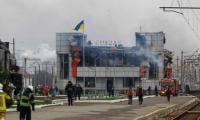Modern economic theorists emphasize the promotion of trade corridors through regional economic integration. Both inter-regional and intra-regional trade corridors are crucial for progress and development.
Regional connectivity is vital for promoting trade and commerce, which, in turn, drives economic growth. Air, land, and sea connectivity – through airports, seaports, and rail/road networks – are particularly important within this regional connectivity framework. The Asian century has just begun its journey to dominate the global economy, with China and India, along with other partners such as Pakistan, playing leading roles.
South and Central Asia hold special significance in the global economic landscape, with regional connectivity emerging as a key driver of progress and prosperity. This region, with a market of nearly 1.9 billion people, has immense potential for trade, leveraging comparative advantages across countries.
However, the total trade volume remains far below potential due to regional conflicts and a lack of interest, challenges that must be overcome to unlock economic growth. The primary need is to build essential infrastructure, such as railways and roads, modeled after the Belt and Road Initiative (BRI) to facilitate trade. The BRI offers an ideal framework for enhancing regional connectivity and boosting inter-regional trade through cost-effective methods.
Infrastructure connectivity can significantly reduce both carriage costs and delivery times. Estimates suggest that freight costs could decrease by as much as two-thirds to three-fourths, with a similar reduction in delivery times for goods transported to destinations like Uzbekistan and other Central Asian states from Pakistan, and vice versa. The same applies to China and, potentially, India, where reduced freight costs and delivery times can greatly benefit trade.
The China-Central Asia-Western Asia Economic Corridor, which links China with the Arabian Peninsula through Central Asia, fosters economic and trade cooperation, bringing countries like Iran, Saudi Arabia, and Turkey closer together for mutual benefit. Similarly, the China-Indochina Peninsula Economic Corridor connects China with Singapore through Vietnam, Laos, Cambodia, Thailand, Myanmar, and Malaysia, strengthening the shared future of China and ASEAN countries.
The China-Pakistan Economic Corridor, a 3,000 km-long flagship project of the Belt and Road Initiative (BRI), connects western China to Pakistan via the deep seaport of Gwadar. This corridor ultimately benefits nearly three billion people across South Asia, Central Asia, and North Africa. Another significant project is the Bangladesh-China-India-Myanmar Economic Corridor, which links South, Southeast, and East Asia, enhancing regional connectivity to boost trade and commerce.
These Chinese-led economic corridors have garnered significant attention and political responses, leading to the development of alternative projects such as the Build Back Better World (B3W) proposed by the G7 countries in 2021, and the India-Middle East-Europe Economic Corridor (IMEC) announced by the G20 countries just a few months ago in New Delhi.
The B3W, rebranded as the Partnership for Global Infrastructure and Investment, is an initiative by the G7 countries aimed at providing an alternative to the BRI for the infrastructure development of low- and middle-income countries. This initiative seeks to address the $40+ trillion infrastructure gap in developing economies, connecting them to developed countries, led by the US, in a manner similar to the BRI led by China.
To further counterbalance Chinese influence in global trade and commerce, the G20 countries introduced another economic corridor, the IMEC, in September 2023 during their meeting in New Delhi. This corridor aims to promote and enhance economic cooperation and integration by linking India to Europe through the Middle East.
The world is undergoing significant transformations in commerce and trade, with economic corridors and infrastructure development playing a crucial role in determining the dominance of the world’s leading economies. The US and its allied democracies are poised to compete with China’s supply chain, particularly in the critical sectors of chips and semiconductors used in emerging battery technologies.
The concept of the BRI has spurred the creation of economic corridors, prompting the US to respond with initiatives like the Build Back Better World (B3W), the Partnership for Global Infrastructure and Investment, and most recently, the India-Middle East-Europe Economic Corridor (IMEC) to counterbalance China. The politics of economic corridors is intensifying, with the new reality being that the global leader will be the one who commands the AI-backed global supply chain through these corridors.
In South Asia, trade and commerce can expand and bring widespread benefits, particularly if the focus is on cooperation among Saarc countries. This region, home to nearly 22 per cent of the world’s population, holds enormous market potential. Trade within Saarc can foster prosperity and growth through cost-cutting measures, reducing carriage and transportation costs. The current economic recession in South Asia and elsewhere could be mitigated through greater regional integration and cooperation.
Hyperinflation and food security challenges can also be better addressed through regional trade if India is willing to promote a development-oriented paradigm rather than pursuing hegemonic designs. It is also evident that mutual trade and commerce between India and Pakistan could play a significant role in reducing inflation across the South Asian region.
A new economic corridor is needed to promote trade through Pakistan, involving India, Afghanistan, and the Central Asian states, complementing CPEC and positioning the region as a key trade hub for Central, South, and Middle Eastern Asia. Pakistan and China could engage India to tap into its vast market while benefiting from the corridor’s route through the mainland, creating a win-win situation for Pakistan.
Pakistan could also consider pursuing a no-war pact and a friendship treaty with India to ensure long-term peaceful coexistence with its neighbors, including Afghanistan, while addressing the Kashmir issue separately. Reviving the Iran-Pakistan-India (IPI) gas pipeline would further enhance this economic corridor, potentially generating nearly $15 billion annually for Pakistan. Overall, revenue from this trade route could exceed $50 billion, significantly boosting Pakistan’s economy.
The critical question regarding global supply chain vulnerabilities is how to mitigate geopolitical and geo-economic tensions that disrupt international trade. While the UN could offer long-lasting peace and stability, this largely depends on the actions of the P5 (the five permanent members of the Security Council) and Germany in stabilizing the global trade market. The Ukraine conflict and the emerging trade war with China are serious threats, with the potential to disrupt global supply chains in the near future.
The US and its allies must recognize that unresolved geopolitical and geo-economic disputes could lead to significant harm and pose an existential threat to the world, especially with the potential use of nuclear weapons. Now more than ever, easing geopolitical tensions is essential for the broader interest of international trade and the stabilization of global supply chain networks.
Enhancing regional connectivity for shared prosperity requires a clear understanding of geo-economic and geopolitical realities. Infrastructure development is fundamental to achieving this connectivity. Building railways and roads is crucial, as several projects are already underway to link China, India, and Pakistan with South and Central Asia to boost trade and commerce. For instance, the proposed rail link between Uzbekistan and Afghanistan, which would eventually connect to Pakistan, could play a pivotal role in promoting regional trade.
Similarly, infrastructure projects like CASA-1000 and the TAPI gas pipeline are vital for linking South and Central Asia, aiming for economic integration and shared prosperity. Promoting these projects is essential to facilitate the free flow of goods and services, with the potential to drive regional economic growth beyond 6 percent.
The writer is a former additional secretary and can be reached at: hassanbaig2009@gmail.com















